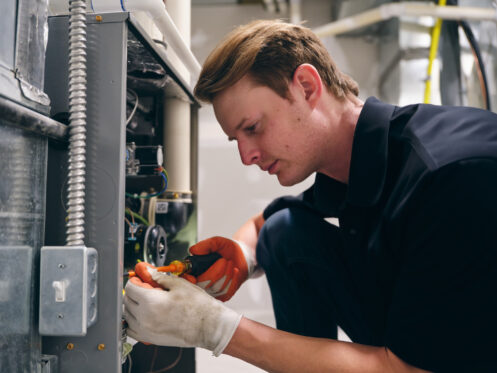Ever since the advent of central HVAC systems, they’ve worked in much the same way. They relied on an indoor unit with a single-speed blower fan and a heat exchanger. For models that offered heat, the indoor unit would also contain a gas burner or electric heating element. Outside, a standalone unit contained a large fan, a compressor, and a heat exchanger to provide air conditioning capacity via the same indoor unit.
However, that setup had an inherent disadvantage. Its ability to only run at a single speed meant that the HVAC would have to run at full power no matter how much heating or cooling your home needed. Today, though, there’s another option called a variable speed furnace. Here’s what they are and six reasons you should consider installing one.
What Is a Variable-Speed Furnace?
A variable-speed furnace is mechanically similar to a single-speed furnace except that it contains an electrically commutated blower motor. This means the motor can operate at different speeds depending on how much electrical voltage you send to it. Variable-speed furnaces also have additional circuitry that helps them run their blower motor at the right speed, depending on how much heat you require. On top of that, variable-speed furnaces often have compatible central AC units that can also take advantage of their multi-stage fans to offer efficient cooling, too.
Reasons to Consider Installing a Variable-Speed Furnace
Variable-speed furnaces have several advantages when compared to single-speed models. Here are six of the most important among them that make a compelling argument for why you should install one.
Energy Efficiency
Perhaps the most important reason to consider a variable-speed furnace is that they are more energy efficient than their single-speed counterparts. Most of the time, a variable-speed furnace will run at a very low speed to maintain your home’s temperature. This uses far less energy than turning on at full power to manage multi-degree temperature swings in your home. On average, a variable-speed furnace will use two-thirds less energy than a comparable single-stage model.
On top of that, you will gain some additional air conditioning efficiency if you pair a central AC with your variable-speed furnace. On average, an AC paired with a variable-speed furnace will gain 1 SEER because of the addition of the variable-speed blower motor. While that may not sound like much, it translates into significantly less energy usage in the summer. That means you get to enjoy much lower energy bills all year round without sacrificing any comfort.
Superior Comfort
Variable-speed furnaces also produce far more comfortable conditions in your home. This is because they work to keep your home’s temperature and humidity stable at all times. The typical single-stage system can produce uneven heating because it produces bursts of warm air whenever it comes on. Then, the system waits for the indoor temperature to drop before coming back on to raise it again. With a variable-speed furnace, your system turns on, reaches the indoor temperature you’ve set, and keeps running in the background to keep it there. This also helps to prevent hot and cold spots throughout your home by recycling the air more often to keep all of it at the same temperature.
Quieter Operation
Since variable-speed furnaces spend most of their time running at low speeds, they’re also much quieter than single-speed models. Although you may have grown accustomed to it, single-speed furnaces make a noticeable amount of noise inside your home when they operate. The sound you hear is a combination of the noise emitted by the blower fan as well as the sound of high-speed air passing through your home’s ducts. Variable-speed furnaces are much quieter because they run at lower speeds almost all of the time. This can all but eliminate the background noise produced by your home’s furnace, resulting in a more peaceful environment.
Improved Air Quality
Variable-speed furnaces also help to improve the air quality inside your home. This happens because they run for longer periods, which recycles the air inside your home more often. Plus, each time the air passes through your furnace, it goes through the furnace’s air filter, removing any dust or dirt that may be present. And if you add a whole-house humidifier or dehumidifier to your system, it will have a much easier time doing its job, too.
Excellent for Zoning
If your home’s ductwork is separated into zones, or you want to add a zoning system, a variable-speed furnace is perfect for that, too. When paired with a zoning system, a variable-speed furnace can produce the exact amount of heat needed at any given time. If multiple zones request heat, it can ramp up its motor to provide it. If only a single zone needs heat, it will run at a lower speed.
This sidesteps one of the major problems associated with single-speed furnaces and zoning systems, which is high static pressure. This can result from the blower fan running at full speed while the zoning system closes off a part of your home’s ductwork. This increases the air pressure in the ducts and makes the furnace work harder than it should, resulting in wasted energy.
Less Heat Exchanger Wear and Tear
Finally, variable-speed furnaces don’t suffer from excessive wear and tear on their heat exchangers. A furnace heat exchanger is made of metal, which expands and contracts as its temperature climbs and drops. This puts stress on the metal, eventually resulting in the formation of small cracks. It is one of the more common ways that furnaces meet their end since a cracked heat exchanger is a danger to a home’s occupants and can be an expensive fix.
In a variable-speed furnace, however, there’s much less expansion and contraction of the heat exchanger. This is because variable-speed furnaces ramp up their fan speeds slowly, which also slowly raises the temperature of the heat exchanger. Then, they run for longer periods while keeping temperatures stable. Therefore, a heat exchanger in a variable-speed furnace is less likely to develop stress-related cracks and can last longer. The same is true of the entire furnace, which should also outlast a comparable single-speed model.
Your Local Variable-Speed Furnace Experts
Since 2005, True Climate Heat + Air has offered HVAC services in Oklahoma City and its surroundings. We provide HVAC installation, maintenance, and repair services, in addition to air quality services, plumbing, and new construction. Our team of HVAC technicians has the latest training and the experience necessary to handle any HVAC-related work you need.
Plus, they’ll do it quickly, efficiently, and while respecting both you and your home. But you don’t have to take our word for it. Just check out our long list of five-star reviews from our satisfied customers. We even offer financing options on approved credit if you need help to afford a new furnace for your Oklahoma City home. Turn to us for heating installation!
So, if you’re interested in a variable-speed furnace for your Oklahoma City home, call on the experts at True Climate Heat + Air today!


